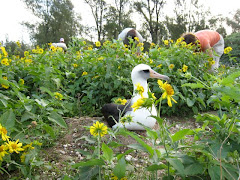
Beginnings
After an informal gathering of a few participants for dinner at an Ala Moana pub the night before, the PAA group (12 participants, 2 alternates and program directors) gathered at the entrance of Haunama Bay on the morning of Saturday, June 12 to begin the adventure of a lifetime, time on Midway Atoll. Everyone got their chance to introduce themselves and say a little about their interests, plans and projects for the upcoming week on the atoll. Then we were all led through a couple of hours of excellent basic instruction on snorkeling by Alan Hong, even though most were obviously well versed in such activity. Although we were only able to paddle around within the very inner part of the famous bay and could only examine briefly the shallow, very near shore, coralline-algal-encrusted relict reef, everyone got a nice introduction/reintroduction to Hawaii's beautiful, always inviting tropical marine water. Doesn't seem like anyone is going to be intimidated by similar settings at Midway; but, how similar is it? Time will tell. After lunch all were indoctrinated in Hawaiian protocol as we entered the PMNM Hawaii Kai office for an afternoon of brief presentations by both monument management staff as well as participants and alternates. Everyone was still gradually getting to know each other while they were gradually owning up to the reality that they were going to Midway. A great first day - it's a process.
Sunday, June 13th, the group really started to come together. Great PowerPoint presentations and videos on a wide variety of introductory topics were presented by the staff, all of which helped to continually build expectations of finally getting to the northernmost coralgal reef atoll complex on the planet. A great presentation was made on research presently being carried out on Midway and throughout the Northwest Islands of the Hawaiian Archipelago, much of which continues to solidify one of the main aspects of the essence of Hawaii, extreme isolation. By definition, when you're the most isolated, you're unique. It seems pretty obvious that if Charles Darwin had ventured by way of the Hawaiian Islands nearly 200 years ago, these islands would be the Galapagos of the planet.
Sunday afternoon was occupied primarily by an interesting, down and dirty work project. Gathering at the Paiko Wildlife Sanctuary along the shoreline of Maunalua Bay, we proceeded to remove invasive pickle weed and then replant a few natives. An amazing amount was accomplished in a relatively short span of time, but even more importantly the group was bonded even more closely together, especially with realization of similarities in goals and work ethics; a great group of talented individuals demonstrating their ability to do great things collectively. Days can't get much better than that.
Monday, June 14th Departure Day. Well, not until late afternoon. The day began with a wonderful, behind the scenes, visit to the Bishop Museum, one of the country's best. We were privileged to be able to examine collections. I was really stoked to be able to see materials, notes, maps and artifacts from the famous 1923-4 Tanager Expeditions, the first real scientific explorations of the Northwest Hawaiian Islands. Items from Necker and Nihoa were displayed; we were allowed to photograph and even touch many of the artifacts. In addition were able to view some of collection of the thousands of native Hawaiian bowls, canoe models, weapons, tapa, pau, etc, etc, etc. At other locations were shown the extensive collections of thousands and thousands of invertebrates and ichthyologic specimens from Hawaii and the tropical Pacific. And finally we were provided time to wander through the wonderful displays of the museum open daily to the general public. What an inspiring place for which Hawaii must feel great pride.
Eventually the beginning had to end and the real journey had to begin. Participants were transported to the airport to first see if they made weight with their under 40 lbs of stuff. Seems like everyone made it. I as one of the hopeful alternates was sad to see all depart without me, but I felt the joy and excitement of the now well-bonded group of adventures. For me being involved in the introductions and meeting such a beautiful, talented group of people was quite a humbling experience, probably one that was somewhat necessary. I know now, more that ever, that I must get to Midway, one way or another.
Respectively submitted
Chuck Blay



















